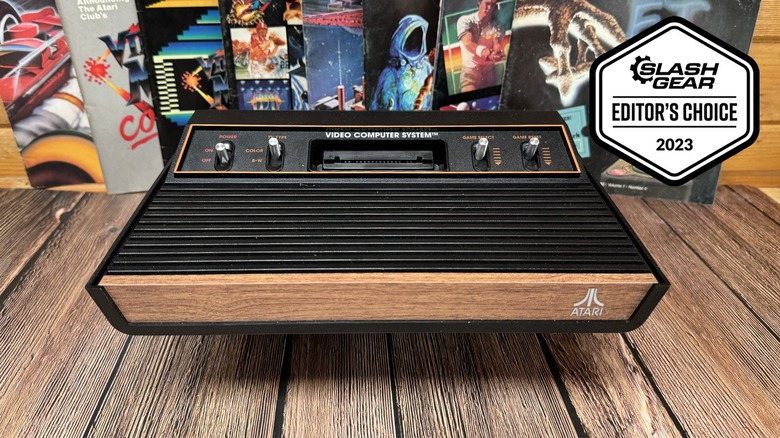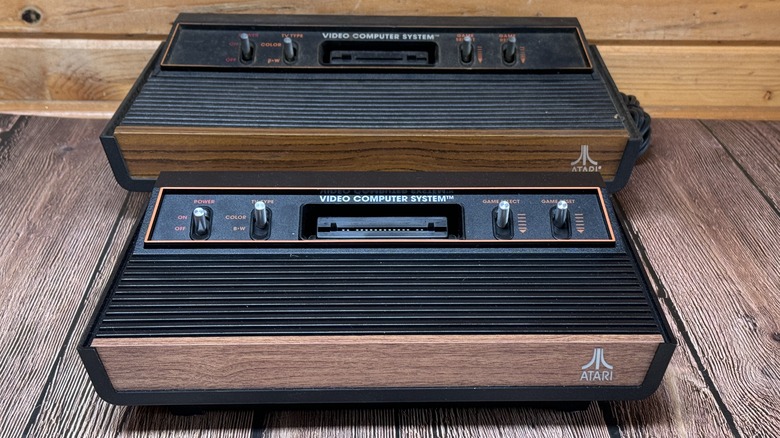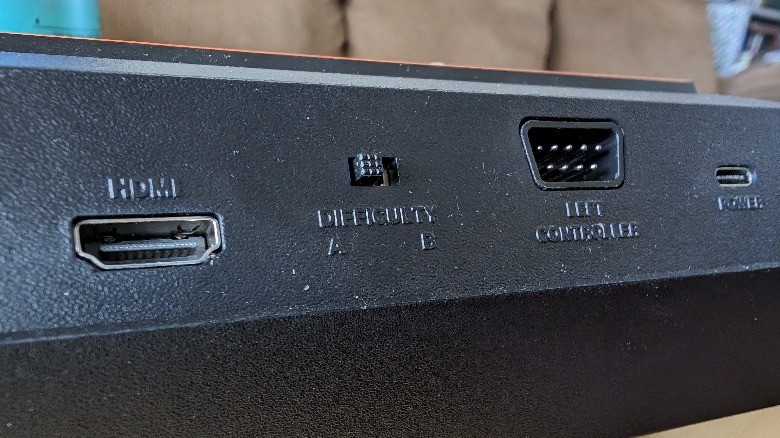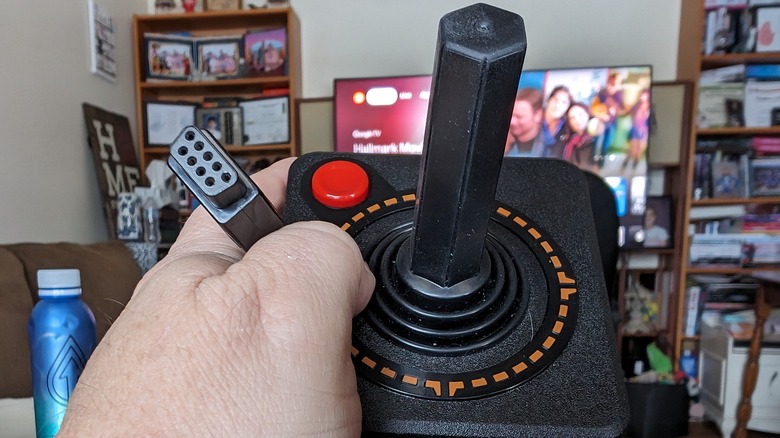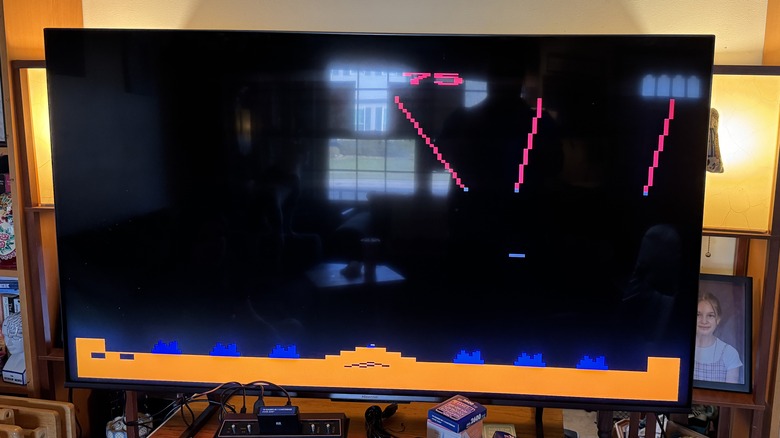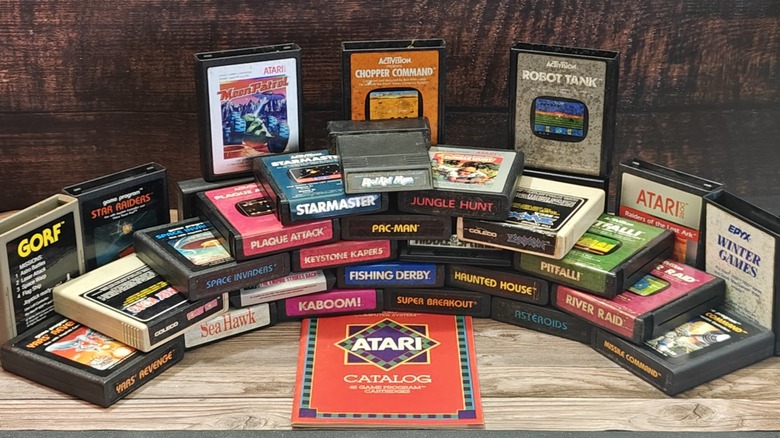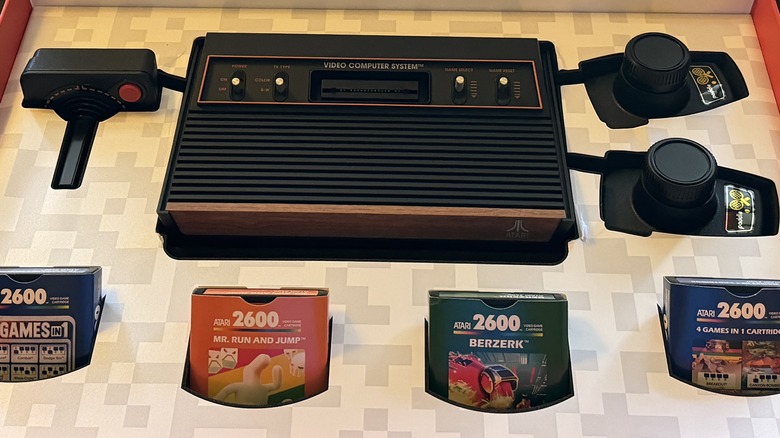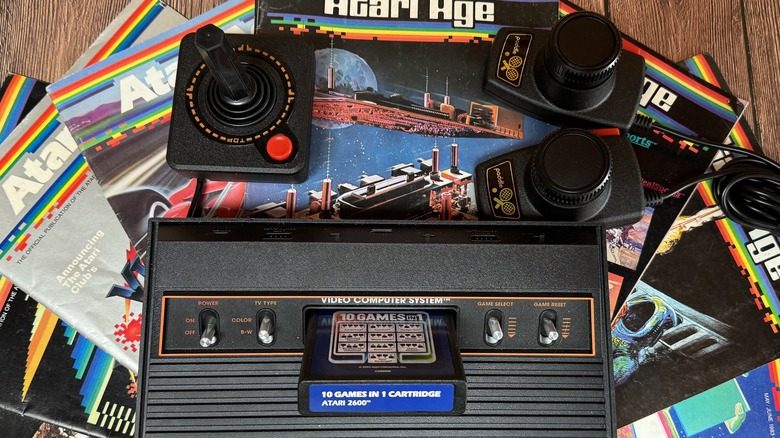Atari 2600 Plus Review: Updated Retro Analog Gaming For Better Or For Worse
- Retains old design with modern improvements
- Backward compatible
- Simple setup and gameplay
- Controllers require exceptional precision for some games
- Second joystick not included
If you were a child of the 1970s or '80s, there is a good chance that you played a game on an Atari game system. The first model — known as the Atari 2600 — was one of the first home game consoles to grace living rooms with titles like "Pac-Man," "Pitfall," and "Yar's Revenge." Each game came on a cartridge that plugged into the console that connected to your TV through an RCA jack, and away you went.
You used a joystick or a paddle that spun to control the game, which by and large was pretty simple. The games were mostly 8-bit meaning they had limited colors and graphics to play with. By today's standards, Atari games were laughably simplistic. But for its time, it was pretty neat.
Atari's first console brought the arcade into your living room. Titles that you had to pump a quarter into a machine to play were now "free" (once you bought the console and the game itself) and at the time, this was a new concept. Fast forward a few decades and Atari is bringing back the console with the Atari 2600 Plus, a new console that plugs into your brand-new television and plays old games with old graphics. Atari provided an Atari 2600 Plus (or Atari 2600+, depending on who you ask), gaming console for the purposes of this review.
Doing it right
It becomes clear the second you open the box that Atari is not messing around with this console. The new console looks nearly identical to the original unit that adorned your living room four decades ago. The key differences are the only modern updates to the system.
First, it's about 25% smaller than the original, which speaks to the size of modern gaming components compared to their 1980 counterparts. Second, and most significantly, the new Atari 2600 Plus comes with an HDMI out and USB-C power port. For those of you wondering if Atari would opt for a micro-USB port, breathe easy. The future is here, and it's Type-C.
Everything else down to the difficulty switches in back to the power, game reset, Color/BW, and game select control levers — not buttons — are the same. The controllers — the joystick with the single fire button and rotating paddles are the same as the original system as well. Plus, they use the same 9-pin connector as the original Atari system, which means exactly what you think it means: you were right, the nay-sayers were wrong — old technology isn't always obsolete.
Old is new again
Everything from the old Atari system — if it survived this long that is — works with the new game system. While the Atari 2600+ comes with 10 games in a single cartridge, you can also buy a CX30 plus paddle controller bundle which comes with dual paddle controllers and four games that utilize the controller including the popular "Breakout." All that is great, but if you have your original cartridges, they will work too. So go ahead and pull those old cartridges out of the crawl space, dust them off a bit, and plug them in.
The original controllers also work, which is great since the Atari system only comes with a single controller, even though some of the games that come with the Atari can be played in two-player mode. It's not particularly surprising that all the old hardware works with the new system. Indeed, if that had not been the case, it would have been a major strike against it. But, it's pretty great, especially for those who saved dozens and dozens of the old cartridges on the off-chance that someday, something like this may come along. Rejoice! Your time is now!
How are the games?
While the nostalgia is strong in this game system, one has to question just how valuable this setup truly is in 2023. These are, after all, 8-bit games, and in a world of "Genshin Impact," "World of Warcraft," "Call of Duty," and more, how much "fun" is playing "Breakout?"
As it turns out, those games are harder than you might remember. Whether it's the foreign nature of the controllers — when was the last time you moved a joystick with anything but your thumb and found yourself limited to just a single button on a controller, after all — some of these games are downright tricky, and it's not just because you lost the 40-year old manual of how to play the darn thing.
You see, unlike modern games, most of which come with an introductory "here's how to play this game" walkthrough, original Atari games didn't have that. So when you're playing "Yar's Revenge" and you see that rectangle coming toward you, you rightly dodge it. When your gun takes a chunk out of the shield surrounding the bad guy, you rightly figure out that you have to blast away the shield to get to the boss underneath. But how in the good green heck are you supposed to know that to destroy the boss, you first have to go touch it, which activates a missile, and then press the button to launch the missile across the screen and get out of its way as it hurtles toward the boss?
Fortunately, one thing that is around today that wasn't back in the 1980s is the internet — and decades of fans of these games have made sure you'll have a fighting chance at understanding what's going on in each game if you're lost.
Games are inventive, and difficult, but a little boring
Remember that we're working with late 1970s technology here. There simply wasn't enough memory nor processing power to do much more than move a "guy" around on the screen, maybe shoot something, and that's about it.
As you progress through levels, games get more challenging. "Missile Command" starts with just a few incoming missiles that you have to shoot out of the air, but later on there are more of them simultaneously, and little alien spaceships too. In "Pac-Man" levels are arranged differently and the ghosts move in more intelligent ways. In "Breakout" the ball you have to intercept gets faster, depending on how you hit it.
All of the games are challenging, possibly due to the limited gameplay and unique controllers by today's standards. However, replayability is very questionable. There are idle tapping games out there that can draw you in with fun animations, funny characters, or an interesting story. Atari 2600 games have little of that.
What they have, though, is a good dose of good feelings and warm memories. Do you want to see the first incarnation of Mario and Donkey Kong? Atari has it. If you want to see an early version of "Frogger," the Atari 2600 has "Freeway." There are many games today that have their roots in the Atari 2600 that have remarkably survived this long.
Updates that could have been
The Atari 2600 Plus is certainly faithful to its original design. The new game console even includes a functional Black and White switch, because back in the day, color TVs could not necessarily be assumed. But there are a couple of areas where improvements could have been made.
The game "Pac-Mac" is incredibly frustrating to play because it has only four directions in which you can move your character — up, down, left, and right. But the joystick recognizes eight different directions, which means when you're playing "Pac-Man," if you don't push the joystick exactly straight up, he simply doesn't go in that direction which is frankly maddening.
What would have been nice would have been a directional switch built into the joystick that limited its movements to those four directions. That way, you could avoid the frustration of getting killed in the first few moments of the game because the controller won't let you go in the direction you want to.
You see, just because you are re-releasing a game console 40 years later, doesn't mean that you have to be stuck with the same technology as the early '80s. There is room for improvement while maintaining the integrity of the original. It would have been nice to see more thought in this particular area.
Atari 2600 plus final verdict
All that being said, is your nostalgia worth $129.99? That's a question you'll have to answer for yourself. If you are someone who played the original Atari 2600 and never really evolved your gaming wants or needs beyond that, the answer is a solid maybe. The value proposition is stronger if you have a whole bunch of the original game cartridges in storage. There are few things more satisfying than blowing the dust off the top of a box, opening it, and seeing dozens of games just ready to be played.
But it's important to remember that these games are from the early 1980s and the gaming industry has changed drastically in the intervening decades. The Atari 2600 Plus is not quite the "baby's toy" that a young Elijah Wood referred to in "Back to the Future II" but it's not far off. The games are not sophisticated, but in short bursts, they can be fun.
If you have little ones, the game concepts can be easy to catch on to (once you search Google for "how to play XYZ game") and don't require the levels of gameplay of modern games. Plus you don't have to worry about knifing someone in an alley and stealing a Gran Turino, or whatever it is you do in "GTA." So they're safe for younger children, which is another plus.
At the end of the day, $129.99 is not a huge sum of money for what you get in this device, so if you have a nerd in your life who's somewhere in their '40s (or a decade or two older), there's a good chance that finding this game system under their tree will bring a smile to their face. It's also likely that it will continue to do so now and then when a dose of nostalgia is in order.
You'll find the Atari 2600 Plus (or Atari 2600+ if you prefer) in the Atari store online. There are a few other iterations of the Atari 2600 that have been released over the past few years that you might also be interested in — but the one we've reviewed here is the version that'll cost you right around $130.
